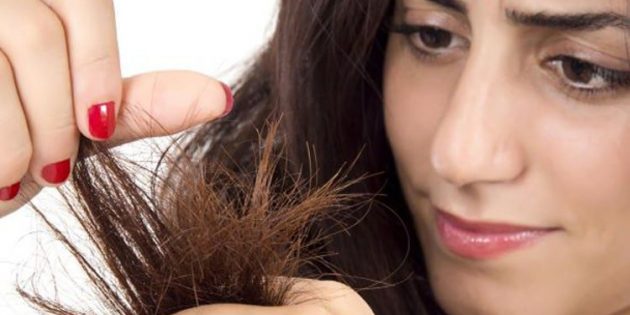What causes split ends?
Split ends happen when the ends of your hair become dry, brittle, and frayed. They may resemble the end of an unraveled rope.
Exposure to extreme weather conditions, and hair care techniques such as blow drying, straightening, and curling may cause split ends. They’re also caused by chemical hair products. With so many people using hair products daily, split ends are common. Almost everyone will deal with split ends at some point.
How to get rid of split ends?
Split ends can’t be repaired. The only reliable way to get rid of them is to cut them off. The latest trend to get rid of split ends is a process called velaterapia, also known as candle cutting. The process was made famous after supermodel Alessandra Ambrosio posted a picture on Instagram of her stylist holding a candle to her hair.
Candle cutting requires twisting a section of your hair and burning it halfway through with a lighted candle. It’s thought that burning off your split ends can create a seal to help protect the ends from splitting again. Still, some hair care experts worry it may actually cause split ends and damage hair follicles.
If you want to try candle cutting, seek the help of an experienced professional. Doing the method on your own may result in burned hair or skin. Hair masks are often marketed as a split end cure. Although they moisturize hair, and may help conceal split ends or help prevent them, they won’t make them go away.
How to conceal split ends?
Hair masks are deep conditioning treatments that help restore moisture to hair and strengthen hair shafts. They’re great for concealing split ends and improving your hair’s overall appearance.
Leave-in conditioners are usually applied to clean, gently towel-dried hair. Sectioning your hair during application may help you apply the conditioner correctly from roots to tips.
You can find hair masks and leave-in conditioners at most drug stores and beauty supply stores, or you can make your own. When preparing your own conditioner, opt for ingredients that help nourish your hair:
Sweet almond oil
Extracted from almonds, sweet almond oil is hydrating and won’t weigh hair down. It may be used neat as a leave-in conditioner or rubbed into damp hair. An added bonus? It smells terrific!
Panthenol
Panthenol is a byproduct of pantothenic acid (vitamin B-5). It helps strengthen hair, retain moisture, and improves the texture of damaged hair. Panthenol is often the main ingredient in many hair masks and conditioners.
Argan oil
Rich argan oil comes from the kernels of argan trees native to Morocco. Argan oil is deeply moisturizing and adds shine to hair. To use argan oil on split ends, rub several drops into damp or dry hair and comb through.
How to prevent split ends?
It’s difficult to prevent split ends. Still, there are things you can do to reduce their frequency and severity.
Tips & Tricks
- Get regular haircuts and trims, preferably every six weeks
- Don’t wash your hair daily. When you do wash, consider only using conditioner and skipping shampoo.
- Choose all-natural shampoos that contain no harsh ingredients.
- Use a conditioner after shampooing or use a leave-in conditioner.
- Use a wide tooth comb to detangle wet hair.
- Limit services that damage hair, such as coloring and chemical straightening.
- Use a heat-protective spray, and minimize the use of heat.
- Take supplements that strengthen the hair, such as biotin and folic acid
Some hairstyles, like ponytails and hair twists, can cause split ends. Limiting how often you wear these hairstyles and using softer hair ties may help prevent damage.
Are some people more prone to split ends?
Although anyone can get split ends, people of African descent may be more at risk. According to a 2015 study, Afro-textured hair is especially prone to damage. This is due to the location of its oval-shaped hair shafts.
It also has a natural retro curvature of hair follicles, slower hair growth, and less hair density. These factors make Afro-textured hair more fragile and more likely to break, as well as to develop knots and split ends.
Women going through menopause may also develop more split ends. As estrogen levels drop, the natural oils produced in the scalp decrease. Hair may become drier and more likely to break.
The bottom line
In general, split ends can impact the look of your hair and, left unmanaged, cause hair damage over the long term.
When it comes to split ends, prevention is key. Although you might have no intention of eliminating your styling tools, using them a little less and keeping your hair well-conditioned may help prevent hair breakage.
Muto, J. (2015, July 10). Burning your hair to get rid of split ends? Some women are trying candle cutting. Retrieved from http://www.today.com/style/women-are-using-candle-cutting-get-rid-split-ends-t30971
Ohnemus, U., Uenalan, M., Inzunza, J., Gustafsson, J. A., & Paus, R. (2006, May 25). The hair follicle as an estrogen target and source. Endocrine reviews, 27(6), 677-706. Retrieved from http://press.endocrine.org/doi/10.1210/er.2006-0020
Panthenol. (n.d.). Retrieved from http://www.cosmeticsinfo.org/ingredient/panthenol
Quaresma, M. V., Martinez Velasco, M. A., & Tosti, A. (2015, September). Hair breakage in patients of African descent: Role of dermoscopy. Skin Appendage Disorders, 1(2), 99-104. Retrieved from https://www.ncbi.nlm.nih.gov/pmc/articles/PMC4857843/



